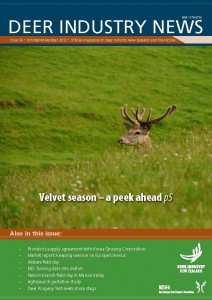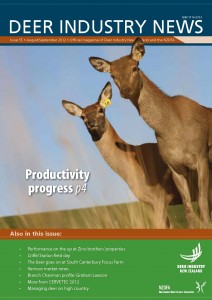 The time for talking is over and the deer industry is about “to do the hard yards”, says Deer Industry New Zealand (DINZ) chairman, Andy Macfarlane.
The time for talking is over and the deer industry is about “to do the hard yards”, says Deer Industry New Zealand (DINZ) chairman, Andy Macfarlane.
Writing in the latest Deer Industry News, Macfarlane says the “industry prize of profitability should be enough to keep us focused on the job.”
The goalpost presented at the 2012 conference has been “determined, reviewed and confirmed as $1.27 per kg venison increase in EBIT by 2022″, achieved from productivity gains alone, Macfarlane explains.
“We also believe we can increase venison tonnage by 50 percent in that time, while simultaneously improving the market return from venison, hence adding to that $1.27 per kg.”
The 50 percent increase in tonnage takes venison output back to a little less than 2007 and 2008 levels, he says, but from an organised stable herd rather than from a reduction of capital stock. The Europe venison marketing strategy and formal access into China and Korea for venison co-products and velvet underpin the on-farm market return. Member processors are now putting together their three-year marketing plans for submission to access increased DINZ funds.
In addition, after consultation with farmers, AgResearch scientists, vets, farm management consultants, processors and educationalists, Primary Growth Partnership funding is being sought from government for on-farm productivity initiatives to deliver an integrated initiative “that we are confident will deliver the additional $1.27 per kg of venison sold,” says Macfarlane, adding that by his calculations it should generate additional industry EBIT of $42 million a year.
To show commitment “by purchasing some of our own ‘training gear’”, industry is being asked to contribute 4 cents per kg of venison fro seven years (initially $900,000 a year).
“The cost is temporary but the return – over $30 per $1 of levy money initially invested – is permanent.”
The title of the PGP bid is ‘The next generation – premium by nature and design’, which he says is significant.
“We have a premium product sold in premium markets. Our animals are pasture-fed and raised in a natural environment. We are poised for our third generation of deer products, produced by our third generation of deer farmers.”
The latest Deer Industry News magazine (Issue 56, October/November 2012), is out now.
 Movember is upon us, so that means men are growing facial hair to raise funds for men’s health charities.
Movember is upon us, so that means men are growing facial hair to raise funds for men’s health charities.


